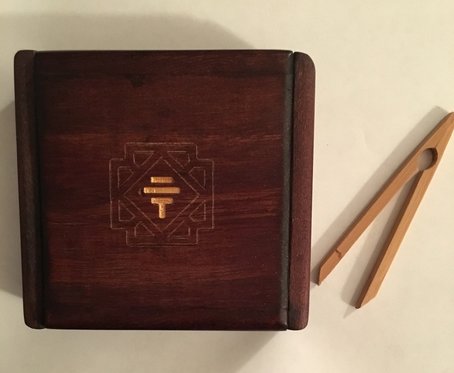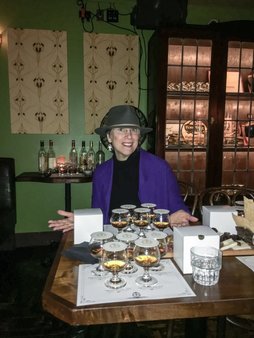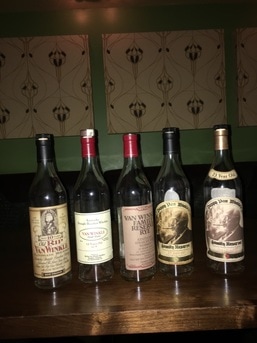
The price-tag of To'ak Chocolate was scandalous enough in 2014 to launch a successful publicity campaign and a flurry of debate within chocolate circles. I looked at the website–very nice– their packaging (see photo)–wood tongs and box made of the same Spanish Elm used during fermentation--okay, conveys a certain attention to detail, still, it screamed HYPE to me.
Produced in Ecuador, the company called the beans "Nacional," but the genetics actually revealed a hybrid. No surprise to anyone who knows the history of Arriba cacao in Ecuador The C-spot rated the To'ak an 8.51 (on a scale of 1-10) and awarded the cumulative with only 3-1/2 stars. Personally, I thought the C-spot had been extremely kind when later I had been able to taste a sample of the 81% for free as a staff reviewer. When I heard To'ak had been awarded heirloom status, I wondered whether someone had been paid-off. But I've been assured there had been no corruption involved. Apparently, with expert handling and a significant amount of sugar (down to 68% cacao), the Heritage Cacao Preservation Initiative produced samples that were indeed worth premium prices. But what is the value of a premium-priced bar? The very best, small batch (1000 bars?) artisan chocolate is priced under $25 for approximately 1.5- 2.5 ounces. In fact, artisan bars vary widely from about $8.99 to $15 for most that are domestically produced. Now, to be fair, To'ak's batch size was only a few hundred bars. Anything produced on so small a scale as to be considered rare, certainly, merits higher prices. But there's a difference between what a producer must charge to make their efforts financially worthwhile and what is realistic to expect consumers to bear. Throw in the fancy-shmancy wood box and tongs, okay--still, come on...
Here's the question that gets to the heart of the matter: Take me, a total chocolate fanatic, who easily plunks down top dollar for quality chocolate, and has to try every bar out there, would I ever pay for a bar of To'ak? No, I would not.
That brings us to the runaway train of inflation in the American whiskey market. To be fair, it's not just American spirits; world whiskies, particularly Scotch and Japanese, have risen astronomically too. But how do you separate value from hype? Well, you have to educate your palate and learn to trust your instincts.
Recently, I've been working on my next book which, I hope, will enable you to do just that, and more. It's about pairing chocolate and spirits. Pairing has become a big area of interest in the last few years–pairing with wine, with beer, with cheese, with your Uncle Tony...
I'm not big on pairing, preferring to focus on one single piece of dark chocolate at a time, and savoring mindfully. Really, isn't a great piece of chocolate enough! If you're really, really tasting it? And personally, I approach whisky the same way–straight, or "neat." I'm just not a cocktail kinda gal. Though cocktails maybe fashionable again, I'm not. But since people are doing this pairing thing, I felt, strictly speaking as a flavor maven, a certain responsibility to help people who are intrigued with pairing, to do it in a way that makes sense and will empower them with the tools to make good choices on their own. Most books, whether on spirits or chocolate, simply throw out a few examples of pairings, then turn you loose on the local merchants. My forthcoming book, working title–The Deep Tasting Guide™To Pairing Chocolate and Whiskey–will present a system for optimal pairing. Hopefully, just as was the goal of my first book, after reading my next, you will be able to trust your own senses and not be bamboozled.
In the process of researching the pairing book, I've had to taste a lot of whisky/whiskey. Think crash course: readings, tastings, purchasing, sweeping drams ordered in bars into my hip flask and stealing off into the night, almost every night. Because if you're going to pair anything, you need to thoroughly know both components. This is the problem with a lot of wine and spirits books already on the bookshelves: They really don't know their chocolate!
I was just discussing this just the other day with the delightful chocolate and wine sommelier, Roxanne Browning. So, yes, I've had to taste a lot of whisky--Scotch, Japanese, Taiwanese, Canadian, French, and whiskey–American bourbon, rye, wheat whiskey, and so on.
Now, I must stress the word "taste" rather than drink. I'm not really a drinker. Truly, I'm not. In fact, I'm sober to such an excessive degree that my resolution for Lent is to give up sobriety. And I'm not doing so well. When working with spirits in my kitchen lab, I usually ingest less than an ounce, probably less than a half ounce. It's a prolonged and repetitive "nosing," then a sip or two. If I'm attending a tasting, I generally don't swallow more than a sip or two there either, and generally only if the whisky is exceptional. I confess to spitting.(They're getting used to me.) But though it may come as a shock to liquor store customers, that's what the master distillers do, so...
I don't like feeling even mildly buzzed. I meditate or exercise when stressed. If you're drinking or eating chocolate to solve stress issues or to anesthetize, let's face it–that's self-medicating. My experience of chocolate, and now spirits, is about actively engaging the senses and savoring. It's about feeling more, not less. So my approach to combining chocolate and spirits is about fully experiencing both, individually and together. A successful match for me is not a matter of simple compatibility, but that something additional, hopefully better, emerges in the form of enhanced or wholly additional flavor notes.
Whiskey hype, American style. Researching whiskey required me to risk a bunch of dollars to gain perspective. So, some time ago, I attended a tasting of rare American whiskey (see photo below). I needed to understand why the Pappy Van Winkle bourbons and Van Winkle Family Reserve Rye were all the rage and selling at such high prices. Why did they cost even more than top of the line, and in some cases 2-3 times more, than relatively rare, superbly crafted Scotch? And now, why were the Van Winkle prices pushing up to cost of other whiskeys in the Buffalo Trace line, particularly the Weller line, said to resemble the Van Winkles in every way but age and space they occupy in the warehouse. While these price surges haven't reached every American whiskey out there, the Van Winkle phenomena has been making an inflationary impact for vast numbers of American whiskeys. The other pressure on price is due to the craft whiskey movement--the topic of a future blog post.
To a large degree, rarity is the operative word with respect to Van Winkle. Whenever you age whiskey or whisky, it means setting the barrels aside and using space for many years. How much of a warehouse can you afford to occupy? Because you need to move merchandise to make any money, aging means deferred profits. Therefore, the distilleries may only put aside a limited number of barrels for long aging (18 or more years). And make no mistake, the supply of Van Winkles is shrinking. But even the Weller line is experiencing a scarcity, whether real or manufactured.
But we would hope that price also reflects quality, not just scarcity, and that aging adds up to a better tasting, richer whiskey. Here's the thing, though, if you're aging in a single barrel, there comes a time when you max out the flavor from the wood. This is why after a certain number of years, the master distillers or malt masters in Scotland, particularly in recent history, do sequential maturing, first for a number of years in oak or ex-American bourbon casks, then another number of years in an ex-sherry casks, then sometimes finishing in still other cask that may have contained port or wines. There may be any number of casks used and any combination, as long as it suits the master distiller. The aging process is a huge part of a malt master's art and the pay off is exquisitely, flavor-orchestrated whiskies. If you were to taste a 12 year old Dalmore or Macallan, then taste one in excess of 20 years, you would see immediately what I mean by increasing complexity. Until recently, that kind of finishing or complexity in aging wasn't really part of American whiskey production.That is changing, however.
For me the 23 year old Pappy Van Winkle is not richer, but thinner, more straight oak than the 12 year or 15 year. A 12 year old Scotch is considered an entry level whisky, but we might consider a bourbon or any other American whiskey, that has not been finished in subsequent flavor casks a product of diminishing returns at some point. Maxed out, past its prime. I'm not saying that the Pappys aren't good. They're very good. But my opinion is that the two-thirds of price is about rarity for the oldest expressions and scarcity, whether real or manufactured, for the younger ones. Therefore, learn to discern flavor and quality. Don't just follow the pack or the buzz. Educate your palate and trust your own perceptions. Then you will never become a victim of hype.


 RSS Feed
RSS Feed